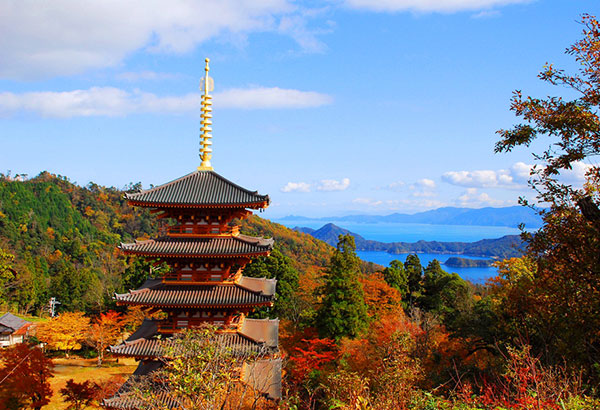The sun rises on new destinations in Japan


Kyoto by the Sea: A temple in Amanohashidate, one of Japan’s three most famous scenic views.
By now, globetrotting Filipinos are probably familiar with Japan’s Golden Route — the cities of Tokyo and Kyoto often visited by first-timers. To encourage them to come back and explore further afield, the Japan National Tourism Organization (JNTO) is opening an office in Manila, and developing interesting new destinations for Pinoys to explore.
“Last year we had over 24 million visitors, not just in Tokyo but other regional areas like Hokkaido and Okinawa,” said Mamoru Kobori, director of JNTO Japan, at the recent Visit Japan Travel and MICE Mart (VJTM) in Tokyo. “Over 20 overseas offices can develop new and interesting familiarization programs. Japan is ready to offer a wide selection of destinations and programs.”
The Land of the Rising Sun aims to welcome 40 million visitors by 2020, and earn US$80 billion from tourism alone. “We told our chiefs to put a lot of effort into infrastructure, hotels, MICE, the Rugby World Cup in 2019 and Olympics in 2020,” said JNTO president Ryoichi Matsuyama. JNTO also wants to go more digital, releasing a smartphone application called the Japan Official Travel App designed to help visitors with everything from free Wifi to baggage storage and train station info.
At VJTM, I met with travel and tour operators eager to welcome Filipinos and help them discover the charms of Japan beyond Tokyo, Kyoto and Osaka. Here are some of the most promising destinations:
Kyoto by the sea
Why it’s worth visiting: Known as the hometown of Toyouke-No-Okami, the god of food and textiles, Kyoto by the Sea is the birthplace of Japanese food culture. The Tango Kuromatsu dining train offers gourmet food while you look at views of the sea and mountains (Amanohashidate is one of Japan’s three most famous scenic views). The area also has a diverse range of sights, from a castle built by a feudal warlord to Buddhist and Shinto shrines and temples, a rose garden featuring 120 types of roses and Chirimen Street, a quaint stretch perfect for selfie-taking in a rented kimono.
Food: Kyoto by the Sea is the birthplace of sake, with 13 breweries in the area. Other native delicacies include the prized Taiza crab (in season from November to March), ine buri or fatty yellowtail fish (in season from December to February and best eaten as sashimi or buri shabu, a hotpot of thinly sliced yellowtail in flavorful dashi broth), and Tango Koshihikari, the highest-ranked Japanese rice.
Souvenirs to shop for: Silk accessories made from Tango Chirimen, the silk fabric used in high-end Japanese kimonos.
Special tip: A free passport is an economical way of touring the entire area, offering unrestricted use of trains, buses, sightseeing boats, cable cars, lifts, and rental bicycles. For more info, contact Kyoto Tango Railway (tel. 0772-25-2323), Tango Kairiku Kotsu (0772-42-0323) or Kyoto Kotsu Co. (0773-75-5000).
How to get there: By train, it’s about two hours from Kyoto Station to Amanohashidate Station.
Tsuruoka: Unesco creative city of Gastronomy
Why visit: UNESCO designated Tsuruoka a Creative City of Gastronomy. With its varied terrain such as mountains, plains, rivers and sea, the city is a major rice-producing region and farms about 50 indigenous crops like Dadacha beans and Atsumi turnips, which have been passed down through generations and are considered “living cultural assets.”
Food: Cherry salmon and cod, mountain vegetables and mushrooms, Tsuyahime rice, bamboo shoots, and edamame are just some of the specialties. Local-dish restaurants abound, including a leading slow-food chef and cooks devoted to disseminating the food culture of Tsuruoka’s Shonai coast. Farm restaurants are gaining popularity as well, while feasts are served at rituals each season.
How to get there: Take a 30-minute flight from Tokyo to Shonai Airport, then shuttle bus to Tsuruoka; by train the JR Uetsu line; or catch the Shonai Kotsu overnight bus from Shibuya and Ikebukuro. For more info, visit www.creative-tsuruoka.jp/.
Central Japan: Mt. Fuji up close, a castle in the sky & Mikimoto Pearls
Why visit: Composed of nine prefectures and three cities located in between Tokyo and Kyoto, Central Japan is a wonderland of treasures yet to be explored. The modern brand names of Toyota, Honda, Mitsubushi and Mikimoto all have their histories in Central Japan.
Don’t miss: Tealeaf or strawberry picking in front of Mt. Fuji in Shizuoka; bathing snow monkeys in Nagano’s Jigokudani Park; John and Yoko’s holiday escape, the boho Karuizawa City; picture postcard-perfect UNESCO World Heritage Villages Gokayama and Shirakawa-go in Gifu and Toyama; Mikimoto pearls in Mie; Ono City’s “castle in the sky” near Fukui; the original home of Japan’s legendary ninjas, Iga City; the Toyota and bullet train museums near Nagoya; the handheld firework festival in Aichi; cycling around geological wonder Lake Biwa in Shiga; and Noto Peninsula, an undiscovered gem in Ishikawa.
Food: You can sit down with an Ama diver for a BBQ, tour a sake brewery, make your own soba noodles, watch a crab fisherman in Fukui pull in from an early-morning trip and cook you fresh crab, and pick strawberries or tealeaves in Shizuoka with Mt. Fuji in the background.
Souvenirs to shop for: Sake, craft beer, knives, washi (traditional paper), gold leaf, pearls, kimono, swords, and ceramics.
Tip: The best way to explore Central Japan is by rental car combined with a JR pass.
How to get there: Central Japan is easily accessed from the Tokyo, Kansai and Central Japan airports; cities like Shizuoka, Hamamatsu and Nagano are an hour or two from Tokyo via Shinkansen. For details, visit www.go-centraljapan.jp.
Yamashiro: Kyoto infused with tea
Why visit: Encompassing 12 cities, towns and a village, the Yamashiro area in the southern part of Kyoto prefecture is the historical center of Japanese green tea production in Kyoto. For 800 years Yamashiro has produced the three forms of tea prepared in Japan: Sencha, the most common; Tencha, which is stone-ground into the fine matcha green tea powder renowned around the world; and Gyokuro, similar to Sencha but grown in covered fields to create the highest-quality tealeaves available, so good you can even eat them after brewing, but expensive: about 10,000 yen for 100 grams.
Don’t miss: Byodo-in Temple, a UNESCO World Heritage site in Uji City; Wazuka town’s spectacular manicured tea fields, which you can cycle through; and hands-on experiences like grinding your own tea, making your own tea bowl, or enjoying a bowl of premium matcha and sweets at Tsuen Chaya, the oldest teahouse in Uji.
Food: Everything green tea, of course, from green tea beer made from powdered Gyokuro mixed with lager, to soba noodles, to ice cream and popsicles; there’s also vegetarian Buddhist temple cuisine, wild game like pheasant sashimi and wild-boar hotpot, and Shokado bento — boxed lunches popularized by the founder of Kyoto Kitcho restaurant.
Souvenirs to shop for: Kyotanabe Gyokuro tea and matcha milk jam, Joyo matcha, Minamiyamashiro-mura black tea, matcha choco-balls, Umeshu plum wine, Seika No Yume shochu, rabbit fortune charms from the Ujigami and Uji shrines, and Arumitoy wooden toys and home décor.
Where to stay: It’s best to use Kyoto as a home base for a series of day trips, but there’s also the Keihanna Plaza Hotel, Kyoto Wazukaso Japanese-style inn, and Farm-inn Maru+jyu.
How to get there: By car or rail from Kyoto or Nara. For details, visit http://ochanokyoto.jp.e.aav.hp.transer.com/.
Eastern Hokkaido: Land of three winters
Why visit: If cold, snow and ice are your thing, winter is Game of Thrones-long in Eastern Hokkaido. Instead of the Long Night, they have early winter, midwinter and late winter, which make the area ideal for skiers. Non-skiers can revel in natural wonders and activities like whale watching, riding an icebreaker ship, or winter canoeing and trekking.
Don’t miss: Among East Hokkaido’s four national parks is Shiretoko, cited by UNESCO as a Natural Heritage Site. Six lakes include the photogenic Lake Mashu, with its incomparably transparent blue water. Two ancient cultures lived in E. Hokkaido: the mysterious Okhotsk people and the Ainu, whose 10,000-year-old culture still survives in Ainu Kotan. The area is also rife with hot springs, like Seseki Onsen, which faces the Sea of Okhotsk and becomes submerged at high tide.
Food: Seafood is king, with freshly caught salmon, scallops, sea urchin and crab available — salmon roe and sea urchin rice bowls are must-tries — but Eastern Hokkaido is also known for tender and sweet Tokachi beef, fresh seasonal vegetables, butter, and sake.
How to get there: To plan your own one-of-a-kind trip, visit http://en.visit-eastern-hokkaido.jp.
* * *
Follow me on Facebook (Therese Jamora-Garceau), Twitter @tjgarceau and Instagram @theresejamoragarceau.



















